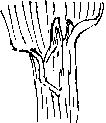 |
Perennial RyegrassSaturday 11th August 2001, West Yorkshire |
![]()
![]()
![]()
![]()
![]()
![]() This Month
Rocks
History
Workshop
Links
Home Page
This Month
Rocks
History
Workshop
Links
Home Page
![]()
The flowerhead is arranged like a herring bone. The 'ribs' alternate while the 'backbone' veers sinuously from side to side between the individual flowers. I tried
 sketching the ligule (left), the straplike membrane in each leaf joint, but this one doesn't quite look like the perfect example in the book. The Reader's Digest Field Guide to the Wild Flowers of Britain describes the ligule as 'short, membranous'. The base of the leaf-blade 'has two claw-like lobes clasping the stem'. I'm going to have to keep sketching these little details to really get my eye in.
sketching the ligule (left), the straplike membrane in each leaf joint, but this one doesn't quite look like the perfect example in the book. The Reader's Digest Field Guide to the Wild Flowers of Britain describes the ligule as 'short, membranous'. The base of the leaf-blade 'has two claw-like lobes clasping the stem'. I'm going to have to keep sketching these little details to really get my eye in.Italian Ryegrass is a similar species that is often planted, but I can tell this is our native Perennial Ryegrass because, in the Italian version, each flowerhead has a projecting bristle. These bristles are botanically known as awns, which comes from a Viking word for 'husk' or 'chaff'.
Related Link
Perennial Ryegrass International Forage Factsheet.![]()
Richard Bell,
wildlife illustrator
E-mail; 'richard@willowisland.co.uk'
![]() Next page
Previous page
This day last year
This month
Nature Diary
Home Page
Next page
Previous page
This day last year
This month
Nature Diary
Home Page
![]()